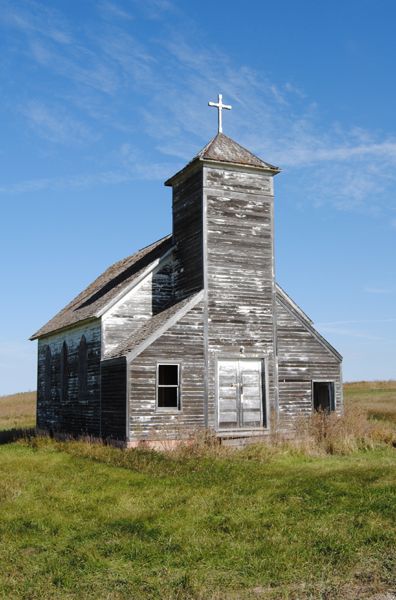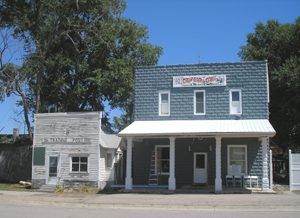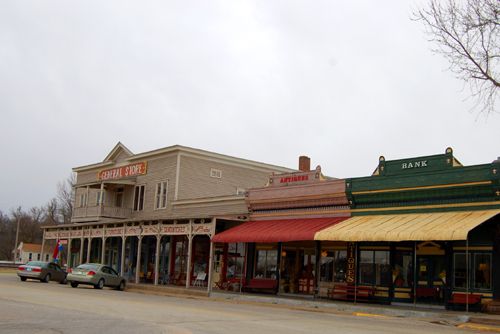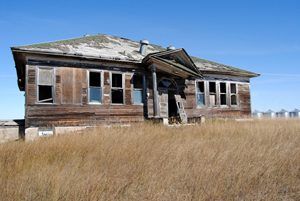
Okaton, South Dakota by Kathy Alexander.
For years, newspapers, locals, and especially farmers have lamented the downward spiral that agriculture has taken over the last century. I heard it as I was growing up in Ulysses, Kansas. I heard it in the news when I moved away from that small town. I continue to hear it on economic updates. But, what I don’t think I ever fully realized, were the ghost towns that the agricultural decline has made across agricultural states.
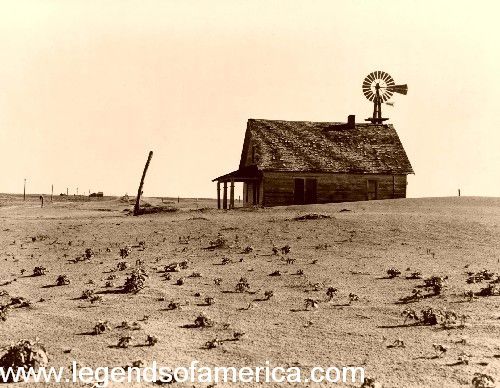
Dust Bowl farm near Dalhart, Texas, photo by Dorothea Lange, 1938.
We’re all familiar with mining ghost towns, historic cow towns, Route 66 ghost towns, and others that died industrial deaths. Many died when the railroads were removed as the population moved to automobile travel. But, the farming ghost towns are something new to me, even though I grew up in the midst of them. To consciously see these dying towns that litter the vast plains is another thing altogether. I mean – really see them.
Friends still live in that small town in southwest Kansas that I grew up in, which, fortunately for them, is not one of the many ghost towns of the plains, as it has other resources such as oil and gas.
As to the many other towns without additional economic venues, I’ve passed by them dozens of times on my way back for a visit without giving a second glance, much less a second thought.
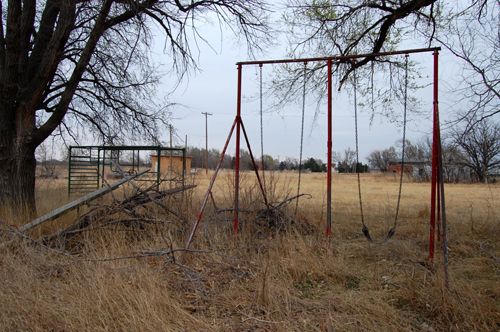
For whatever reason, I am enamored with old schools and playgrounds so often found in these emerging ghost towns. This old playground in Nekoma, Kansas, sits silently today as its swings and teeter-totters sway in the gusts of the Kansas wind. Kathy Alexander.
However, that changed recently as I intentionally went across Kansas for a more in-depth look at Kansas’ small towns, many of which I have to categorize as “emerging ghost towns.” My photographer’s eye sends flutters of excitement through me at the opportunity for shots of crumbling buildings, old trucks, tractors, and boarded-up businesses. My mind thrills with the anticipation of learning the history of these old settlements, checking out historic cemeteries, and as always, wondering about the people that once thrived in the paint-peeling houses, boarded-up buildings, and crumbling barns.
But, on this trip, the excitement is dampened as these are “new” ghost towns. Those people that once prospered in the now decaying structures might very well be my father’s friends, they were certainly the parents or grandparents of people I know, and many are still alive – living down the street, watching their towns crumble around them.
Though I love to visit ghost towns and photograph old buildings, it’s so different when you can relate to the people who once lived and still reside there. Definitely not the same as visiting an old mining town that thrived a century ago. My heart aches for those people who put their lives into building businesses, farms, and beautiful homes that now stand, paint peeling, and windows were broken without a potential buyer in sight. The farms are still there – most very big. A few “plots” are small, like the ‘ole days, but of those, their homes are generally in the same condition as the towns they are near.
Though this may be the first time I’ve noticed these emerging “ghost towns,” this phenomenon is not new. From North Dakota to the Texas Panhandle, and the east and the west, small towns of the Great Plains have declined in population for 75 years.
During the great days of westward expansion, the American West was born not only of cowboys, railroaders, miners, lawmen, and outlaws; but, more importantly, and often overlooked, were the many homesteaders and businesses who supported them, who provided the backbone of these many dying communities.
Rarely do we hear about those hardy people in modern writings, but their work ethic and values were primarily responsible for establishing these many Main Streets, schools, churches, and homes that, too often, sit abandoned today.
The decline of the farmer began in the 1930s after the Great Depression when many lost their land due to heavy debt. The dustbowl days drove more from their lands, leaving thousands of acres of abandoned land in their wake.
On its heels, however, came progress – better machinery, hybrid seeds, and large irrigation systems. With enhanced technology, those remaining farmers could handle more land than they could in the past, and the farms grew bigger. But, the agricultural operations could no longer support all of the children, as it took less manpower, and the offspring began to move away.
When farms get bigger, fewer farmers are on the same land. This affects the small towns that support them – the grocery and hardware stores, the doctors and lawyers, churches, and schools. As the population falls, these operations eventually close or move to other locations.
And, what is left, as the children move to the cities in search of jobs and the merchants relocate their businesses elsewhere? Abandoned buildings and homes with no potential buyers and the elderly who have spent their lives in the community and want to stay. Eventually, they too will pass, again leaving no buyers, and the town, without the commitment of hard-working and enthusiastic residents, fades more and more.
I spoke to a gentleman in this predicament who had recently abandoned his spacious house and was now living in a trailer home. “Why,” I asked, to which he responded, “I can’t afford the upkeep on the old place. It was cheaper to buy the trailer.” One cannot argue individual needs; most of these little towns don’t have “enough to offer” from a historical perspective to qualify for historic preservation grants or funds.
Amazingly, some small towns have pulled themselves up by the bootstraps and survived by remaking themselves into “boutique communities” with their historic buildings occupied with antique shops and a quaint restaurant or two. One great example is Paxico, Kansas, which continues to preserve its historic buildings with individual enterprises, festivals, and events that draw tourists and help to keep the town alive.
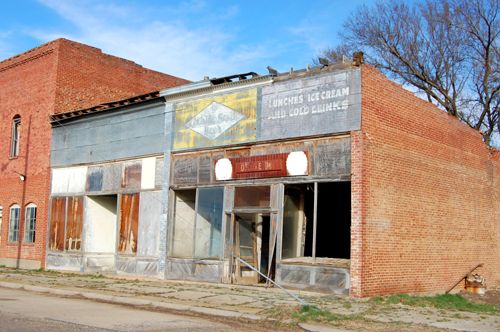
The east side of Main Street in Barnard, Kansas, has not fared well. Across the street, however, the post office and a bank are still in business, by Kathy Alexander.
This effort started with one individual several years ago and spread enough to keep the town from becoming a “ghost.” The locals, however, said that many in the community would have preferred that Paxico had never developed into a “tourist attraction.” It might be surmised that some of these little places have totally died due to the residents’ resistance to change. In the meantime, Paxico continues and has a population of about 200 today.
It is interesting to observe what their final open businesses are in these small towns. In many cases, if the location is on a railroad, the only open business is the grain elevator. Others that have faired a little better may have a post office and, interestingly, a bank (perhaps some national financial institutions could take some lessons from these small-town banks.) One such place is Barnard, Kansas, where the bank and the post office still survive, surrounded by several abandoned businesses on its lonely Main Street. If the community is near a major highway, it might provide a convenience store/gas station. If there are any service businesses left at all, a few still have a beauty/barbershop. And, in yet more, the only remaining business is a saloon. It is fascinating to see the priorities.
But, for many other small towns, little is left but crumbling buildings and weed-choked yards. For some, their fate is even worse. Unfortunately, I inadvertently stumbled into one small Texas town called Lela as I took a detour off of I-40. Once on old Route 66, it was one of the few little towns I hadn’t yet visited. Taking photos, stopping often, and making notes, I was approached by a burly young man who came bounding out of a house so dilapidated it had no business hosting any occupant other than rodents. He came directly to the car; sure I was there to see him for some purpose. After convincing him I was only there to take a picture of the old church across the street, I high-tailed it out of town. Later, I received a lecture from my brother-in-law about how dangerous it was to have been in this tiny community, which is known to be filled with meth labs and drug addicts.
Adventurer that I am, in some ways, I can be quite naïve. Unfortunately, it hadn’t dawned on me that these small towns have sometimes become a haven for drug houses that operate their businesses “under the radar.” If I was sad to see the condition of these old towns before, it was heart-breaking to discover that they have sometimes become havens for criminals. I’ve had other “scary” experiences in some of these old places before — being approached by odd characters and being followed on foot and in vehicles. Though sometimes, these folks are just looking after the property, other times, their intentions are unclear.
I’m more cautious now. I no longer venture into ghost towns, even though I’m drawn to their desperate beauty. I’m enticed by the history, the old “homesteading” mentality, the work ethic, the pioneer spirit, and the memories. In some cases, I’m thrilled to find exactly that; in others, the town has fallen into such despair that only the lowest of the low will inhabit it. If nothing else, I think I have seen first-hand some of the reasons a place becomes a true “ghost town.”
© Kathy Alexander/Legends of America, updated March 2023.
Also See:
Ghost Towns, Mining Camps, History & More
The Homestead Act- Creating Prosperity in America

